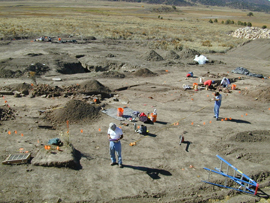A 7-year archaeological project in support of the Animas–La Plata Project outside of Durango, Colo., has resulted in a rewriting of the prehistory of the Four Corners Region.
The ALP Archaeological Project occurs in the locale of Ridges Basin Dam and Lake Nighthorse. Since 2002, Reclamation has conducted data recovery to address impacts from construction and reservoir development. It has investigated more than 74 sites in accordance with a rigid, scientific-sampling strategy. The work in the project area concentrates on pit-house villages dating to the early Pueblo I time period (750 to 850 A.D.) of the Ancient Pueblo (Anasazi) occupation. These sites are much earlier, and precursor to, the famous cliff dwellings at nearby Mesa Verde (which date to the 1200s). The Ridges Basin people were among the earliest farmers in the northern Southwest and among the first to settle in villages.
Investigators for the Ute Mountain Ute Tribe, under the leadership of Dr. James Potter, SWCA, Inc., are employing a multistage process to answer questions project findings have posed. The process, which investigators carry out by using cutting-edge techniques, involves the following:
- Fieldwork: Using electronic-data storage (Total Station and GPS) instrumentation to provide horizontal and vertical control while excavating pit houses, surface rooms and midden (trash) areas. Recovery included collection and field conservation of artifacts and other materials.
- Analysis of materials: Carrying out basic and specialized analyses, including chronometry (dating); ceramics; stone tools; faunal (animal) remains; human remains; geomorphology; and plant and soil samples.
Specific, remarkable, findings include the earliest cultural feature — a fire pit — ever discovered in the Durango area (12,000 years old). A second was the discovery that this is not the first time an impoundment existed at the site of Lake Nighthorse. During the Pueblo I occupation, a natural lake or marsh existed in the same area. A third is the discovery of the foundation of a tower structure on Sacred Ridge, in the center of Ridges Basin. This is the earliest evidence of a tower structure in the Southwest.
What is probably the most remarkable is the brief but intense occupation of Ridges Basin. Ridges Basin, at its peak at about 800 A.D. was home to hundreds of people living in pit-house villages. However, more precise analysis indicates the area was occupied for less than 100 years. This provides an ideal case study for examining how and why communities form and eventually disintegrate. As such, the ALP Archaeological Project plays not only a significant role in the development of the cultural history of the region, but of the understanding of early village formation and decline from a global perspective.



 Print Version
Print Version
 E-mail This Article
E-mail This Article
